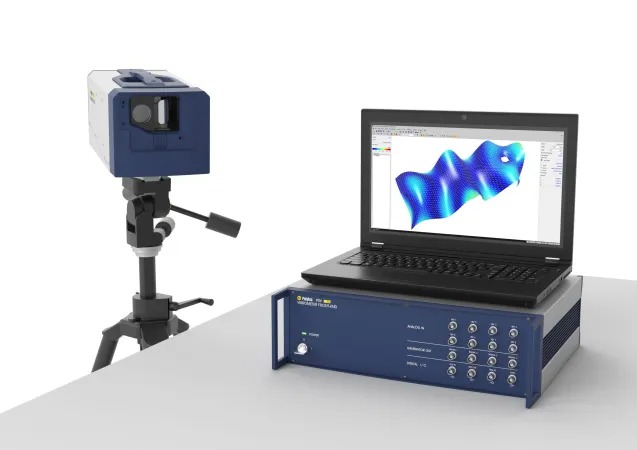While the laser light is reflected back to the photodetector without loss on optically smooth surfaces, measurement surfaces are usually optically rough in practice, which can lead to broadband noise and unwanted signal dropouts. This is precisely where the patented QTec technology from Polytec comes in, as it significantly improves the signal-to-noise ratio for vibration measurements.
A multi-detector concept, in which backscattered signals reach multiple photodetectors, is the key to this. It means that surface irregularities hardly play a role anymore because – to put it simply – less light is lost during reflection. High-speed electronics in the sensor head measure the detector signals in real time; the user is provided with a common measurement signal, making the new sensor heads compatible with the current single-channel vibrometer decoders.
Reliable Data and Shorter Measurement Time
 Higher optical sensitivity is the basis for better data quality and higher productivity: the new multi-path interferometry helps to obtain reliable measurement data, even in demanding measurement tasks, e.g. on moving, distant or rotating test specimens, and it also works on poorly reflecting surfaces such as human skin. In addition, measurements become faster. Up to now, a poor signal-to-noise ratio was partially compensated for by averaging multiple measurements. The new approach means that four to ten times fewer averages are needed, depending on the applications. This significantly reduces the measurement time. Furthermore, low-noise vibration measurements can even be performed in applications where averaging is not possible because of the time factor, e.g. when the distance traveled by an object is to be determined, or while measuring the pulse in humans.
Higher optical sensitivity is the basis for better data quality and higher productivity: the new multi-path interferometry helps to obtain reliable measurement data, even in demanding measurement tasks, e.g. on moving, distant or rotating test specimens, and it also works on poorly reflecting surfaces such as human skin. In addition, measurements become faster. Up to now, a poor signal-to-noise ratio was partially compensated for by averaging multiple measurements. The new approach means that four to ten times fewer averages are needed, depending on the applications. This significantly reduces the measurement time. Furthermore, low-noise vibration measurements can even be performed in applications where averaging is not possible because of the time factor, e.g. when the distance traveled by an object is to be determined, or while measuring the pulse in humans.
The new QTec technology is available as a sensor head for the existing VibroFlex system from Polytec (optionally with the VibSoft-VL software for digital acquisition and evaluation of the data) and as a scanning vibrometer in a compact version or as a 3D version for the acquisition of all vibrational directions. The scanning vibrometers are always supplied as a turnkey system with integrated data acquisition and 3D visualization of the deflection shapes.
For more information: www.polytec.com
Tags: 3d vina, Faster and More Precise Measurement of Optically Rough Surfaces, hiệu chuẩn, hiệu chuẩn thiết bị, máy đo 2d, máy đo 3d, máy đo cmm, sửa máy đo 2d, sửa máy đo 3d, sửa máy đo cmm
